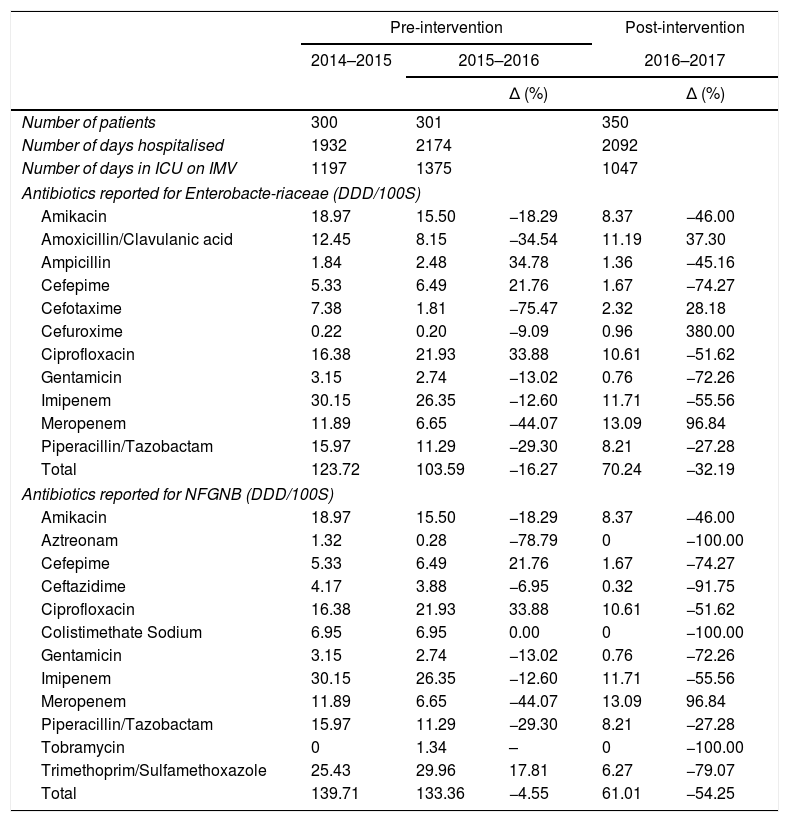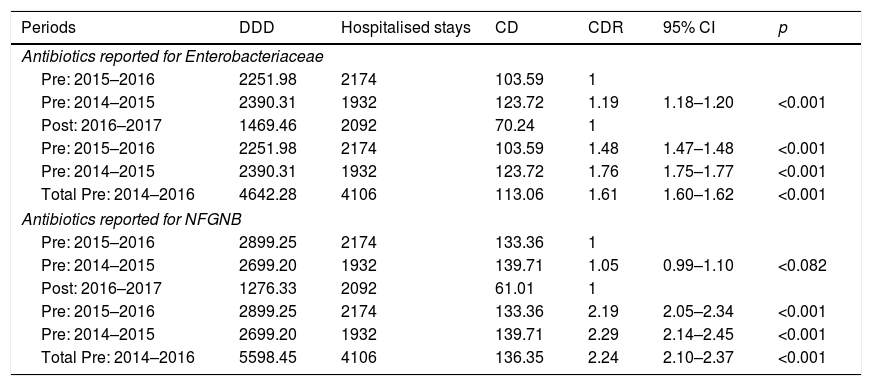Due to the favourable impact of removing the sinks on isolations in bronchoaspirate samples of patients with mechanical ventilation, we now evaluate the impact on the consumption of antibiotics as well as on the results of the Zero Resistance Project (ZRP).
Patients and methodsAll the patients admitted to the unit in a quasi-experimental before–after study with a pre-intervention period between 2014 and 2016 and a post-intervention period from 2016 to 2017, to evaluate antibiotic consumption in defined daily doses, and until 2018, to evaluate the ZRP indicators. The intervention was the removal of the sinks from the rooms of the ICU. We evaluated antibiotic consumption densities and their ratios, grouped as Enterobacteriaceae and non-fermenting gram-negative bacilli (NFGNB) according to their antibiograms; the absolute number of ‘antibiotic days’, ‘hospitalised days’, ‘isolation days’, and ‘multi-resistant bacteria (MRB) days’; as well as their incidence densities per 1000 hospitalised days and the ratio between the two years prior to and the two years after the intervention.
ResultsPost-intervention antibiotic use was 1.61-fold (1.60–1.62) and 2.24-fold (2.10–2.37) lower for antibiotics used against Enterobacteriaceae and NFGNB, respectively. There were also reductions in the number of days of antibiotic use by 1.29-fold (1.22–1.36), number of MRB days by 1.84-fold (1.63–2.08), and number of patient isolation days by 1.51-fold (1.38–1.66).
DiscussionThe results suggest that the intervention had a favourable impact on the consumption of antibiotics, as well as on the number of days on antibiotics, MRB, and isolation.
Debido al impacto favorable de la retirada de los lavabos sobre los aislamientos por bacilos gramnegativos no fermentadores (BGNNF) en muestras de broncoaspirado de pacientes con ventilación mecánica, ahora evaluamos el impacto en el consumo de antibióticos, así como en los resultados del Proyecto Resistencia Zero.
Participantes y métodosTodos los pacientes ingresados en la unidad en un estudio cuasi-experimental antes-después, con período preintervención entre 2014-2016 y postintervención, desde 2016 hasta 2017 para la evaluación del consumo de antibióticos a través de dosis diarias definidas y hasta 2018 para evaluación de indicadores del Proyecto Resistencia Zero. La intervención consistió en la retirada de los lavamanos de los boxes de las UCI. Se evaluaron las densidades de consumo y sus razones, agrupando según los antibiogramas informados para enterobacterias y BGNNF; del Proyecto Resistencia Zero: los «días de antibiótico», «días de estancia», «días de aislamiento» y «días de bacterias multirresistentes (BMR)» de forma absoluta y mediante sus densidades de incidencia por 1.000 días de estancia, y su razón entre los 2 años previos a la intervención y los 2 posteriores.
ResultadosLos consumos postintervención resultaron 1,61 (1,60-1,62) y 2,24 (2,10-2,37) veces inferiores, para antibióticos frente a enterobacterias y BGNNF, respectivamente. Se redujeron 1,29 (1,22-1,36) veces los días de antibiótico, 1,84 (1,63-2,08) los días de BMR y 1,51 (1,38-1,66) los días de aislamiento.
DiscusiónLos resultados sugieren un impacto favorable de la intervención tanto sobre el consumo de antibióticos, como en los días de antibiótico, de BMR y de aislamiento.










